Abstract
Geothermal energy is a type of renewable energy that has rich reserves, is clean, environmentally friendly and has been widely used in the heating industry. The single-well closed-loop geothermal system is a technology with the characteristics of “taking heat without taking water” and is mainly used for geothermal energy heating. Although the heating requirements in the cold region of Northeast China are urgent, the traditional heating mode not only has high economic costs but also causes serious damage to the environment. Therefore, it is of important practical significance to change the heating structure and develop and utilize geothermal energy for heating according to local conditions. In this study, the actual operating single-well geothermal system in the Songyuan area of Jilin Province is used as a case study, and a numerical model is established based on the T2WELL simulation program. The flow production temperature and heat extraction response law of the single-well system in the M1 and M2 wells are contrasted and analyzed under the three key factors of geothermal gradient and injection temperature and flow rate. Based on the simulation results, an optimized development and utilization plan for the M1 and M2 wells is proposed. These results provide a theoretical reference and heating potential evaluation for the promotion of single-well geothermal systems in Northeast China. Taking the geothermal gradient of 4.2 ° C/hm as an example, after 30 years of operation, the heat extraction of the M1 well is 406 kW, and that of the M2 well is 589 kW. Compared with the M1 well, although the M2 well has higher heat extraction, the radial variation in reservoir temperature is more than 50 m under long-term operation, which is not conducive to long-term development and utilization.
1. Introduction
With climate change becoming a potentially irreversible threat to society, renewable energy has attracted worldwide attention. Geothermal energy is a clean, sustainable and widely-distributed form of renewable energy, which has been developed and utilized on a large scale by more than 80 countries in the form of heat pumps, space heating, bathing and power generation []. The development and utilization of geothermal resources can effectively reduce greenhouse gas emissions, which is important for achieving the transformation of energy structure and the “double carbon” strategic goal [,,]. Northeast China has long and cold winters, and therefore, an urgent need for heating, but traditional heating methods create environmental problems, while also bearing high heating costs [,]. Heating methods urgently need to be moved in a clean, low-carbon and economical direction []. On 30 November 2022, the Energy Administration of Jilin Province released the “14th Five-Year Plan for Controlling Total Coal Consumption in Jilin Province”. This plan states that geothermal energy resources should be developed scientifically and utilized in an orderly manner according to local conditions. In industrial development zones, tourist attractions, new residential areas, government-invested public buildings and other areas, the use of medium- and deep-level geothermal energy will be carried out to create a “geothermal Sanxia of the whole region”. This shows that the promotion of geothermal energy heating in the cold areas of Northeast China is of great significance.
At present, geothermal energy development includes shallow ground source heat pump, medium and deep buried pipe and deep artificial thermal storage fracturing technologies []. The medium and deep buried pipe technology includes single-well, U-shaped-well and doublet-well systems [,] (Figure 1). Single-well closed-loop geothermal systems have the feature of “taking heat but not water”, and the heat exchange of coaxial casing can be realized by circulating the injected fluid in the closed system []. Compared with the ground source heat pump technology, the heat exchange fluid of single-well systems does not enter the ground but only flows between the wellbore and the original groundwater flow; chemical and stress fields are not damaged. Compared with U-shaped-well and doublet-well systems, not only are single-well systems adaptable, but they also possess the advantages of low construction costs []. In addition, the operation of single-well systems is not dependent on climatic conditions, which ensures the long-term, stable and efficient operation of geothermal systems [].
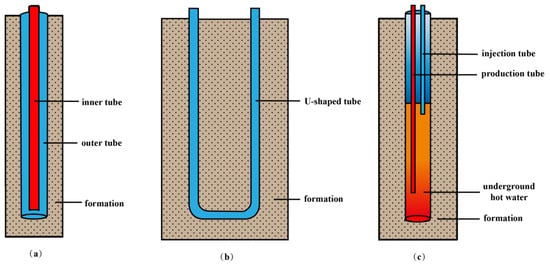
Figure 1.
Schematic diagram of medium–deep buried pipe system. (a) Single-well system. (b) U-shaped well system. (c) Doublet-well system.
Many researchers in China and internationally have studied single-well closed-loop systems. Falcone and others [] analyzed the advantages and disadvantages of the current development of single-well closed-loop systems. Cui and others [] proposed a single-well enhanced geothermal system based on a single-well system in combination with hydraulic fracturing and analyzed the economic feasibility of this technology. Yu and others [] established a new enhanced deep well heat transfer system through a concrete material with high thermal conductivity to improve the heat extraction efficiency of this technology. Bu and others [] comprehensively analyzed the effects of insulation material properties, injection water temperature and flow rate on the system performance by establishing the flow heat transfer equation of the fluid in the geothermal well and the energy equation of the rock. Song and others [] studied and analyzed the coaxial casing closed-cycle heat extraction technology in Xiongan New Area by combining numerical simulations and field trials and made an economic analysis of the different thermal storage conditions and insulation structures based on the field conditions. Hu and others [] studied the fluid flow and thermal processes of CO2 instead of water in the single-well closed-loop systems, and the heat-extracting mechanism was analyzed. A new Antoine–based correlation for a water–CO2 mixture was proposed for geothermal applications by Niknam and others []. Leontidis and others [] carried out modeling of the reinjection of two-phase non-condensable gases and water in geothermal wells. All of the above discussions have provided an important reference and ideas for the establishment of models in this research.
For the cold area of Northeast China, it is of great practical significance to accelerate the change in heating structure and develop and utilize geothermal energy for heating in accordance with local conditions. However, the development of single-well geothermal systems in the cold region of Northeast China is still lacking sufficient theoretical guidance. Therefore, in this study, a conceptual model was established by a numerical simulation method, and the existing single-well system in the Songyuan area was used as a reference. The T2WELL simulation program was used to analyze the heating efficiency of the single-well closed-loop geothermal system in terms of geothermal gradient, water injection temperature and flow rate and other elements. The response of each element was optimized by combining the simulation results, so as to propose a reasonable development plan for a single-well closed-loop geothermal system in a well group, which provided a theoretical basis and a reference direction for future research on the large-scale development of a single-well closed-loop geothermal system in the cold region of Northeast China.
2. Study Area
In this study, the existing single-well system in the Songyuan area was used as a reference. The geological conditions of the Songyuan area are thin in the Cenozoic Era, where the total thickness of the Quaternary and Neogene systems is only 100 m. The lower strata are, in order, the Upper Cretaceous Nenjiang, Yaojia, Qingshankou, Quantou and Dengluku groups. From the surface to a depth of 2100 m, the main body of the formation is mudstone with a small amount of sandstone. Below 2100 m, the main body of the lithology is granite basement (Figure 2) [].
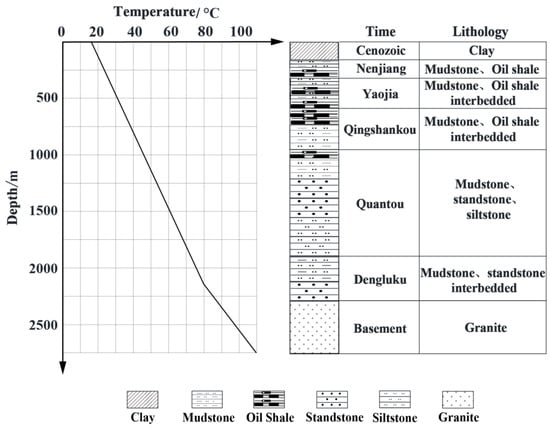
Figure 2.
Lithology and well temperature records of research domain [].
From the data of previous studies and logging data, the temperature measurements in the Songliao Basin at a depth of 3000 m below the ground are in the range of 101–138 °C with an average temperature of 124 °C []. The average geothermal gradient is 3.8 °C/hm. The average heat flow of Songliao Basin is ~73–79 mW/m2, significantly higher than the national average of 61.5 mW/m2 []. It can be seen that the Songyuan area is rich in geothermal resources and has excellent potential for heating with the potential for the large-scale development of geothermal energy.
In addition to its abundant geothermal resources, the Songyuan area has extremely rich experience in the development and utilization of single-well closed-loop geothermal systems. At present, the single-well system located in the Songyuan Economic Development Zone, Jilin Province, has been operating successfully for 4 years, with a cumulative heating area of 10,000 m2 within the site and economic benefits of RMB 5.3 million, thereby providing valuable experience for the large-scale promotion of geothermal single wells in the Songyuan area.
3. Fundamentals and Mathematical Model
3.1. Fundamentals
The basic principle of a single-well closed-loop geothermal system is shown in Figure 3. The system consists of three parts: production wells, injection wells and a rock reservoir []. The heat exchange fluid exchanges heat with the formation through the injection well, and the hot water is pumped from the bottom of the well to the ground through the insulated production well for use. The annular hollow part in the middle of the injection and the production well is used as the water injection port. The production well is used as the extraction channel, and the two wells are connected at the bottom. The fluid flows in the injection well and is pumped out from the production well after reaching the bottom of the well. The cold water is injected through the injection well for heat exchange with the reservoir. In addition, the whole underground system is completely closed without destroying the original underground flow and chemical fields.
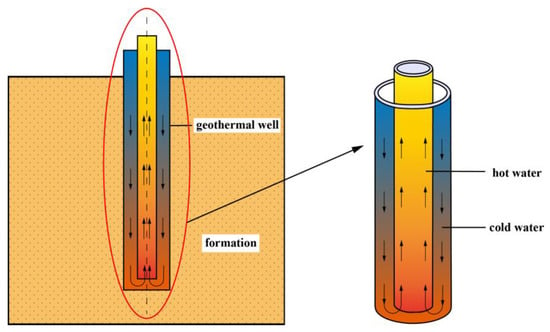
Figure 3.
Schematic diagram of single-well closed-loop geothermal system.
3.2. Mathematical Model
The wellbore–reservoir coupling calculation process is the key for achieving accurate water–heat coupling numerical simulations in a single-well system. During the whole operation process, the hydrothermal migration processes involved are as follows: (1) the fluid flow and heat transfer process in injection wells; (2) the hydrothermal migration process of fluid in production wells; (3) heat exchange between fluid and reservoir during fluid migration.
During the operation of a geothermal well, the heat transfer process proceeds as follows: geothermal reservoir—cement layer wrapped outside the wellbore—injection well pipe—fluid inside the well. Therefore, the mathematical model should mainly consider the heat transfer equation between each heat transfer medium. For the analysis of the heat transfer situation, the model is assumed to be a homogeneous formation, and the energy loss during the transfer process is neglected so that the heat transferred from the rock reservoir to the wellbore is equal to the heat transferred from the wellbore to the fluid.
3.3. Fluid Flow and Heat Transfer Equation in Injection Wells
The heat exchange process in the injection well mainly occurs between the reservoir and the fluid in the injection well.
where TR is the temperature (K) of the fluid in the injection well, t is time (s), v is the fluid flow rate (m/s) in the well, z is the vertical depth (m), SrR is the heat transfer (K/s) between the recovery and injection wells, SRS is the heat transfer (K/s) between the fluid and the well wall, hR is the convective heat transfer coefficient (W/(m2·K)) of the inner well wall, r3 is the inner radius (m) of the inner casing, Ts,wall is the temperature (K) of the well wall in contact with the fluid, ρ is the density of water, AR is the injection well circulation area (m2), and CP is the specific heat capacity (J/(kg·K)) of water.
3.4. Fluid Flow and Heat Transfer Equation in Production Wells
The heat exchange process in the production well mainly occurs in the fluid of injection well and production well.
where Tr is the temperature (K) of the fluid in the production well, k1 is the heat transfer per unit length(W/(m·K)), and AR is the production well circulation area (m2).
3.5. Convective Heat Transfer Coefficient
The Convective heat transfer coefficient mainly depends on several parameters of the fluid itself.
where hr2 and hr1 are the convective heat transfer coefficients (W/(m2·K)) of the outer and inner walls of the extraction well, respectively, λ is the thermal conductivity (W/(m·K)) of the convective liquid, Re is the Reynolds number of the fluid, Pr is the Prandtl number of the fluid, de is the hydraulic diameter (m), and r1 is the outer radius (m) of the inner casing.
3.6. Boundary and Initial Conditions and Initial Condition
The heat transfer from the rock to the well wall is equal to the heat transfer from the well wall to the fluid, and the contact between the three is given by the third type of boundary condition:
where λw is the thermal conductivity (W/(m·K)) of the rock, TW is the rock temperature (K), r4 is the outer radius (m) of the inner casing, r4 = r3 + bs, bs is the thickness (m) of the inner casing, Tw,0 is the initial temperature (K) of the rock, Tsur is the surface temperature (K), Tg is the geothermal gradient (K/m), and z is the distance from the surface (well depth) (m).
Since this simulation only involves the heat transfer process between the wellbore and the reservoir, the initial conditions of the simulation only consider the temperature and pressure conditions, where the temperature conditions are calculated according to the geothermal gradient selected by the scheme, and the pressure conditions are uniformly distributed according to the hydrostatic pressure.
4. Numerical Simulation
4.1. Numerical Simulation Code
The TOUGH2-WELL (T2WELL) simulation program is a tool mainly used to simulate non-isothermal multiphase flows in coupled wellbore–reservoir systems []. The program was developed by adding a wellbore grid to a reservoir grid based on the original software TOUGH2, thus enabling the simultaneous calculation of flow coupling in the wellbore and reservoir [,]. The TOUGH procedure uses the integral finite difference method and the unconditionally convergent implicit difference method for spatial discretization and temporal discretization, respectively. One of the modules, EOS1, was specifically designed for hydraulic geothermal modeling and has now been incorporated into T2WELL. In addition, a version of parallel computing that can handle the significant computational burden caused by the large number of grid meshes was developed based on the parallel program introduced by Feng and others [].
4.2. Simulation Parameter Selection
A single-well system at a depth of 2300 m was put in place in the study area. To improve the simulation accuracy, it was necessary to use the measured data obtained from the operation of the system during the heating season. It was also essential to calibrate the lithological parameters related to the permeability, thermal conductivity and specific heat capacity of the stratum in which it was located by fitting the results obtained from the model calculations to the measured data for the flow production temperature profile under heating conditions. By debugging the relevant parameters several times, the accuracy of the model could be improved so that it could better reflect the actual engineering.
The simulation injection temperature and circulation flow rate were selected according to the actual site heating data in the Songyuan area. The main part of the study area from the surface to 2100 m underground is a mudstone layer mixed with a small amount of sandstone. The part below 2100 m is granite base, so the geological reservoir can be mainly generalized into two layers: mudstone and granite. The parameters of the two layers are different, and the initial parameters of the model are determined by referring to the relevant information and the values taken by previous authors [,,], with the debugging carried out on this basis. Figure 4 shows the fit of the measured production flow temperature profile to the simulated data profile.
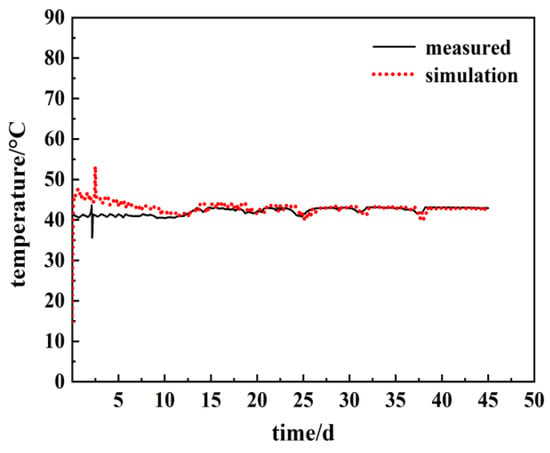
Figure 4.
Produced flow temperature fitting curve.
It can be found from the fitting curve that the simulated temperature is slightly high in the early stage of model operation. This is mainly because the initial stage of the simulation is in adaptive operation, the injection flow is relatively large and the reservoir temperature is high, so the simulated temperature is high. In summary, the selected parameters of this simulation are reasonable, and the fit is good. The final selected simulation parameters are shown in Table 1.

Table 1.
Model numerical simulation parameters.
4.3. Simulation Strategy
The main performance indicators of a single-well geothermal system include the outlet water temperature, heat extraction (thermal power) and thermal reservoir temperature []. The main factors affecting these three indicators are well depth, well diameter, geothermal gradient, reservoir thermal conductivity, run time, injection temperature and mass flow rate. This study combines the actual engineering demand and realistic heating needs in the Songyuan area, mainly for the simulation under two well depth conditions of 2500 and 3000 m. The depth of the M1 well is 2500 m, and the depth of the M2 well is 3000 m, and the heat exchange law analysis is carried out by combining three key conditions of geothermal gradient, water injection temperature and injection flow rate. By summarizing the above simulations, we finally propose a reasonable development plan for the single-well closed-loop geothermal system in the cold region of Northeast China. Table 2 presents the set up for the specific simulation scenario.

Table 2.
Numerical simulation strategy.
5. Analysis of Factors Influencing Production Temperature and Heat Extraction
5.1. Influence of Geothermal Gradient
According to the injection temperature of 25 °C and injection flow rate of 30 m3/h, the rest of the simulation parameters were selected according to the previous selection. The simulation results curves of the flow production temperature and heat extraction for different geothermal gradients for the M1 and M2 wells are given in Figure 5.
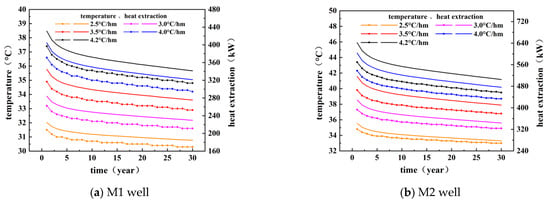
Figure 5.
Comparison of production temperature and heat extraction under different geothermal gradients.
As can be seen from Figure 5, the M1 well produced temperatures of 31.5, 33.2, 34.9, 36.6 and 37.4 °C in the first year of operation at geothermal gradients of 2.5, 3.0, 3.5, 4.0 and 4.2 °C/hm with heat extractions of 225, 285, 345, 405 and 431 kW, respectively. The production temperatures for continuous operation up to the 30th year were 30.3, 31.6, 32.9, 34.2 and 34.8 °C. The corresponding heat extractions were only 184, 230, 275, 321 and 341 kW, with extraction decreases of 18.2%, 19.3%, 20.3%, 20.7% and 20.9%, respectively.
It can be seen that in the early stage of geothermal well operation, the production flow temperature is high, and a substantial heat extraction can be obtained, but as the operation time continues, the production flow temperature gradually decreases, and the heat extraction also decreases. The main reason for this is that as the operation time continues, the heat of reservoir is continuously absorbed, and the reservoir temperature continues to decrease, so the production flow temperature and heat extraction also decrease. The lower geothermal gradient has relatively good stability under long-term operation, and the extraction drop is relatively small, but the flow-producing temperature and heat extraction are lower due to the lower reservoir temperature. The reason for this is that the reservoir temperature is low, and the temperature drop is relatively small. As the geothermal gradient increases, the heat extraction of geothermal wells rises very significantly, so places with large geothermal gradients are more suitable for single-well geothermal development.
The M2 well could reach 342, 429, 516, 603 and 642 kW of heat extraction in the first year of operation at the above five geothermal gradients. The corresponding heat extractions for continuous operation up to the 30th year were 277, 344, 410, 476 and 505 kW with heat extraction decreases of 19.0%, 19.8%, 20.5%, 21.1% and 21.3%, respectively. The increase in heat extraction was significant when the well depth increased. Compared to the M1 well, the heat extraction gains in the M2 well were 117, 144, 171, 198 and 211 kW at five geothermal gradients in the first year of operation and 93, 114, 135, 155 and 164 kW after 30 years of operation, respectively. By comparing the M1 and M2 wells, it can be found that the increase in well depth increased the flow path of the heat transfer fluid in the wellbore, resulting in a significant increase in the heat transfer area and therefore a significant increase in the produced flow temperature and heat extraction. However, the decrease in heat extraction under long-term operation was larger compared to the lower well depth, which may not be conducive to sustainability.
After this comparison, it can be found that an increase in well depth can make up for a low geothermal gradient, and the development of single-well geothermal systems in places with low geothermal gradients should appropriately increase the depth of the geothermal wells. Simultaneously, the higher the geothermal gradient, the greater the power gain obtained from the increase in well depth, but the long-term operational stability is relatively poor, and the heat extraction drop is large.
5.2. Influence of Injection Temperature
According to the geothermal gradient of 4.0 °C/hm and the injection flow rate of 30 m3/h, the rest of the simulation parameters were selected according to the previous section. The simulation curves of the produced flow temperature and heat extraction for different injection temperatures for the M1 and M2 wells are shown in Figure 6.
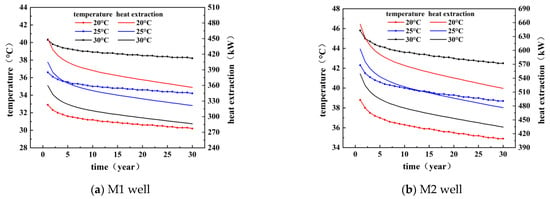
Figure 6.
Comparison of production temperature and heat extraction at different injection temperatures.
The M1 well produced water at 32.9, 36.6 and 40.3 °C and 450, 405 and 360 kW of heat in the first year of operation at injection temperatures of 20, 25 and 30 °C, respectively. After 30 years of continuous operation, the production temperatures were 30.2, 34.2 and 38.2 °C, and the heat extractions were 356, 321 and 286 kW with extraction decreases of 20.9%, 20.7% and 20.6%, respectively.
In the first year of operation, the M2 well produced water at 38.8, 42.3 and 45.8 °C and 657, 603 and 549 kW of heat at injection temperatures of 20, 25 and 30 °C, respectively. After 30 years of continuous operation, the production temperatures were 34.9, 38.7 and 42.5 °C, and the heat extractions were 518, 476 and 434 kW with extraction decreases of 21.2%, 21.1% and 20.9%, respectively.
These results show that as the injection temperature increased, the production flow temperature increased in both the M1 and M2 wells, showing a positive correlation, but the heat extraction then decreased, showing a negative correlation. The higher the temperature of the injected water, the more difficult it is to exchange heat with the reservoir, and it may not be able to fully absorb the heat, which is the main reason for this phenomenon. Higher injection temperatures not only play an important role in maintaining the stability of geothermal wells for long-term continuous operation (multiyear operating extraction reduction) but also allow for higher effluent temperatures, albeit at the expense of heat extraction. The lower the injection temperature, the higher the heat extraction and the more favorable for heating, but this does not mean that a single lower injection temperature is optimal. A low injection temperature also leads to a limited increase in the temperature of the water coming out, meaning that the process of extracting heat after the water is pumped out of the geothermal well becomes difficult, and the heat extraction process may be more costly.
5.3. Influence of Injection Flow
According to the geothermal gradient of 4.0 °C/hm and the injection temperature of 25 °C, the rest of the simulation parameters are selected according to the previous section. The simulation curves of the flow production temperature and heat extraction at different injection temperatures for the M1 and M2 wells are shown in Figure 7.
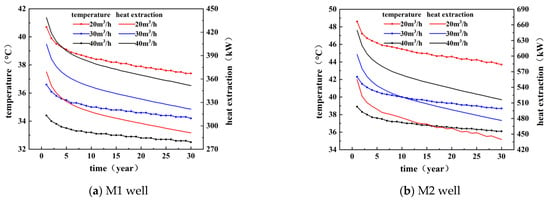
Figure 7.
Comparison of production temperature and heat extraction at different injection flows.
In the first year of operation, the production temperatures of the M1 well were 40.7, 36.6 and 34.4 °C, and the heat extractions were 369, 405 and 439 kW at injection flow rates of 20, 30 and 40 m3/h, respectively. After 30 years of continuous operation, the production temperatures were 37.4, 34.2 and 32.5 °C, and the heat extractions were 291, 321 and 352 kW with extraction decreases of 21.1%, 20.7% and 19.8%, respectively.
In the first year of operation, the production temperatures of the M2 well were 48.6, 42.3 and 38.9 °C, and the heat extractions were 556, 603 and 649 kW at injection flow rates of 20, 30 and 40 m3/h, respectively. After 30 years of continuous operation, the output water temperatures were 43.7, 38.7 and 36.1 °C, and the heat production powers were 435, 476 and 516 kW with power decreases of 21.8%, 21.1% and 20.5%, respectively.
In summary, it can be found that the injection flow rate is negatively correlated with the temperature of the produced flow, and the higher the flow rate, the lower the temperature of the produced flow. The higher the injection flow rate, the more water that is exchanged with the reservoir for heat exchange per unit time, which also leads to a lower temperature of produced flow. However, there is a positive correlation with heat extraction, and the change in heat extraction is very obvious as the flow rate gradually increases. The high injection flow rate can improve the stability under continuous operation for many years, and the extraction variation under multiyear operation is relatively small. Although a larger injection flow rate will produce higher heat extraction, in actual engineering, the diameter of a single well is usually small, basically within 1 m, which cannot guarantee an injection flow rate that is too large. An excessive flow rate will also accelerate the decay of the flow production temperature with time, which is not conducive to the sustainable development and utilization of geothermal single wells.
5.4. Geothermal Energy Optimization
Summarizing the above multiple sets of simulation scenarios, patterns can be derived from three key factors:
(1) The geothermal gradient is positively correlated with the flow production temperature and heat extraction of the geothermal wells. The development of a single-well system is more effective in areas with high geothermal gradients, while areas with low geothermal gradients require deeper wells to increase their development value.
(2) The injection temperature is positively correlated with the flow production temperature of the geothermal well and negatively correlated with the heat extraction. Too high an injection temperature is not conducive for obtaining substantial heat extraction, while too low a temperature increases the difficulty of thermal extraction.
(3) The injected flow rate is positively correlated with the heat extraction of the single-well system and negatively correlated with the produced flow temperature. The higher the flow rate, the higher the heat extraction, but the injected flow rate should not be too high, otherwise it will make the temperature of the produced flow lower and the thermal extraction difficult.
Among the three influencing factors, the geothermal gradient has the greatest influence, followed by the injection temperature and the injection flow rate with the least influence. The geothermal gradient is limited by geothermal geological conditions and cannot be changed artificially. Thus, if we want to increase the heating area of a single geothermal well, we need to lower the injection temperature and increase the injection flow rate as much as possible. The above three laws were integrated, assuming that 100,000 m2 of heating was required; a single-well closed-loop geothermal system was selected for heating; and two kinds of wells, M1 and M2, are used as the starting points, combined with key factors, so as to propose the optimal layout of the single-well system for heating, in order to achieve the optimal working conditions.
5.5. Analysis of M1 Well Heating Potential
In this simulation, an injection temperature of 20 °C and an injection flow rate of 40 m3/h were chosen. The simulation results under five geothermal gradients are shown in Figure 8.
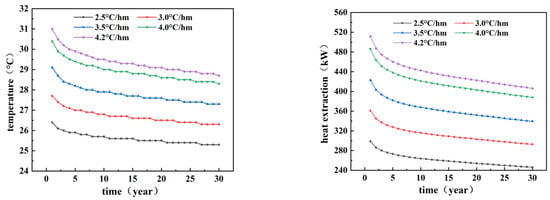
Figure 8.
Optimized production temperature and heat extraction for M1 well at different geothermal gradients.
From Figure 8, it can be found that when the geothermal gradient is 2.5 °C/hm, the heat extraction is 299 kW in the first year of operation and 246 kW after 30 years of operation. According to the national heating standard of 38 W/m2, the heating area can be 7868 m2 in the first year and 6474 m2 after 30 years of continuous operation. When the geothermal gradient is 4.2 °C/hm, the heat extraction is 511 kW in the first year of operation and 406 kW after 30 years of operation, and the heating area is 13,447 m2 in the first year and 10,684 W/m2 after 30 years of continuous operation. The specific simulation results are shown in Table 3.

Table 3.
Simulation results of M1 well under different geothermal gradients.
From these simulation results, it can be found that the M1 well is relatively small in depth and cannot obtain a high flow production temperature and heat extraction in areas with a low geothermal gradient, which makes the development of the M1 well unsuitable. It is more valuable to develop the well in areas with a high geothermal gradient that is 1.7 times more the heating area at 4.2 °C/hm than at 2.5 °C/hm. Therefore, the M1 well is more suitable for areas with high geothermal gradients.
5.6. Analysis of M2 Well Heating Potential
The same injection temperature and flow rate as for the M1 well were used in this simulation. The simulation results under five geothermal gradients are shown in Figure 9.
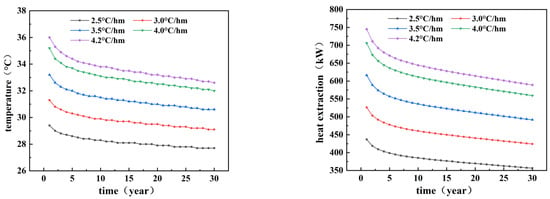
Figure 9.
Optimized production temperature and heat extraction for M2 well at different geothermal gradients.
We found that when the geothermal gradient is 2.5 °C/hm, the heat extraction is 437 kW in the first year of operation and 357 kW after 30 years of operation. According to the national heating standard of 38 W/m2, the heating area can be 7868 m2 in the first year and 6474 m2 after 30 years of continuous operation. When the geothermal gradient is 4.2 °C/hm, the heat extraction is 511 kW in the first year of operation and 406 kW after 30 years of operation, and the heating area is 13,447 m2 in the first year and 10,684 m2 after 30 years of continuous operation. The specific simulation results are shown in Table 4.

Table 4.
Simulation results of M2 well under different geothermal gradients.
The relatively large depth of the M2 well allows for a higher flow production temperature and heat extraction under the same conditions compared to the M1 well, but the increased depth of the well also makes the well more expensive to drill.
5.7. Design of Optimal Development Plan
A comprehensive analysis of the above two wells led to the following patterns:
(1) M1 wells are more suitable for development in areas with high geothermal gradients.
(2) M2 wells are more suitable for development in areas with low geothermal gradients.
(3) Lowering the injection temperature and increasing the injection flow rate as much as possible can obtain more heat extraction for heating.
If at least 100,000 m2 of heating is required, the M1 or M2 well is selected for development for different geothermal gradients, and a simple static payback period estimate is made on this basis []. Table 5 shows the design of the development schemes under different geothermal gradients.

Table 5.
Design of development schemes under different geothermal gradients.
It could be found that although the cost of drilling a single geothermal well is lower for the M1 well compared to the M2 well, the number of wells required to meet the heating demand of at least 100,000 m2 needs to be increased accordingly, so the total cost would be relatively higher, and the payback period would be relatively longer.
Although the payback period of the M2 well is short, the service life of geothermal wells may also be shortened due to long-term high-flow operation, so the change in geothermal field temperature before and after the extraction of geothermal wells is analyzed using a geothermal gradient of 4.2 °C/hm as an example (Figure 10).
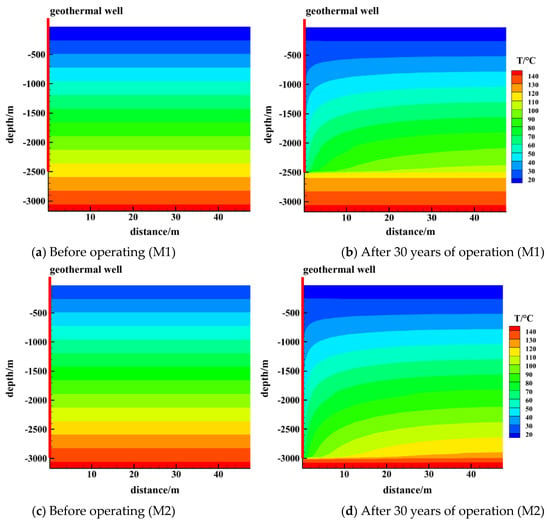
Figure 10.
Temperature field diagram of M1 and M2 wells before and after operation at 4.2 °C/hm geothermal gradient.
It could be found that after 30 years of continuous mining in the M1 well, the temperature of each temperature zone decreases more obviously and the radius of influence gradually increases with depth, but it can still barely maintain the original temperature of each temperature zone, and the development can still be continued under such mining intensity. However, after the M2 well was subjected to long-term continuous mining, the temperature change in the reservoir was very obvious, and the radius of influence was significant. The reservoir temperature in the near-well area decreased by more than one third, and it became very difficult to develop again under the original mining intensity. This is also the reason why heat extraction produces a significant decrease. This also reflects the fact that although the M2 well can obtain more heat extraction, it comes at the cost of reduced service life.
The results of the above analysis show that the M1 well is more suitable for areas with high geothermal gradients, and the M2 well is more suitable for areas with low geothermal gradients. Areas with high geothermal gradients can make up for the lack of well depth by their own higher reservoir temperature, while areas with low geothermal gradients can fill the lack of their own reservoir temperature by increasing the well depth. If the heating demand of 100,000 m2 is to be met, the input cost of the M1 well is relatively large and the payback period is long, but the temperature change in the reservoir is relatively small, and the service life of the geothermal well is longer, which is more suitable for sustainable development. The input cost of the M2 well is smaller, and the payback period is shorter, but the temperature change in the reservoir is significant, and it is relatively difficult to meet the needs of long-term development and utilization.
In addition, reasonable well spacing is also an important factor affecting the sustainable development of the single-well geothermal system. It can be inferred from Figure 10 that the influence radius of temperature change under long-term continuous exploitation is large for both M1 and M2 wells. If the well spacing is too small (less than 50 m), the heat efficiency of multiple groups of single wells will be significantly reduced. Therefore, when developing multiple groups of single-well systems, the well spacing should be as large as possible. For example, the temperature influence radius of the M1 well is smaller than that of the M2 well, so the well spacing of the M1 well can be appropriately smaller than that of the M2 well, but it should not be too small. According to previous studies [], under such a scale of exploitation, the well spacing should be at least not less than 60 m. If conditions permit, the well spacing can be increased to more than 100 m. This measure is also more conducive to the long-term development and utilization of the single-well system.
6. Conclusions
To summarize the research in this study, the following conclusions can be obtained:
(1) The development of single-well systems is very dependent on geological conditions. When the ground temperature gradient is 2.5 °C/hm, the heat extraction of the M1 well is about 225 kW, and that of the M2 well is about 342 kW. When the ground temperature gradient reaches 4.2 °C/hm, it can reach 431 kW and 642 kW, respectively. The geothermal gradient is positively correlated with the flow production temperature and heat extraction of single-well systems, and the larger the geothermal gradient, the higher the corresponding flow production temperature and heat extraction.
(2) The injection temperature is positively correlated with the production flow temperature of the single-well system but negatively correlated with the heat extraction, while the injection flow rate is negatively correlated with the production flow temperature and positively correlated with the heat extraction. The effect of injection temperature on the heat extraction is more pronounced than that of the injection flow rate. Although lowering the injection temperature and increasing the injection flow rate can increase the heat extraction, it will lower the production flow temperature, and the low production flow temperature will increase the difficulty of heat extraction.
(3) Areas with high geothermal gradients are more suitable for the M1 well with smaller well depths due to higher reservoir temperatures, while extending the service life of single-well systems. However, if a single well-system is to be developed in areas with low geothermal gradients, a larger-depth M2 well is more appropriate due to the lower reservoir temperature. For example, when the geothermal gradient is higher than 3.5 °C/hm, it may be more appropriate to select the M1 well with a long service life.
(4) To meet the heating demand of 100,000 m2, the cost of developing M1 wells is relatively high, and the payback period is long, but a longer service life can be obtained. The cost of developing M2 wells is relatively low, and the payback investment period is short, but the useful life may be short. Taking the 4.2 °C/hm geothermal gradient as an example, the payback period of the M1 well is 4.4 years, and that of the M2 well is 3.9 years. However, the radial temperature response of the reservoir is more obvious. Therefore, the well spacing should be guaranteed to be at least 60 m when large-scale well cluster deployment is carried out.
Author Contributions
Conceptual model and numerical simulation, B.F. and H.R.; Visualization and writing, Z.C.; Funding acquisition and resource, J.Z.; Project administration, Y.Y. All authors have read and agreed to the published version of the manuscript.
Funding
This work was supported by the National Natural Science Foundation of China (No: 42072331, U1906209).
Data Availability Statement
The original contributions presented in the study are included in the article. Further inquiries can be directed to the corresponding author.
Conflicts of Interest
The authors declare no conflict of interest.
References
- Lund, J.W.; Toth, A.N. Direct utilization of geothermal energy 2020 worldwide review. Geothermics 2021, 90, 101915. [Google Scholar] [CrossRef]
- Daarnhouwer, M. Assessing the Potential of Deplete Gasfields for Geothermal Energy. Ph.D. Thesis, Delft University of Technology, Delft, The Netherlands, 2013. [Google Scholar]
- Bruhn, D.; Jolie, E.; Huenges, E. European research efforts on engineered and superhot geothermal systems within horizon2020(Conference Paper). Trans.-Geotherm. Resour. Counc. 2018, 42, 2381–2395. [Google Scholar]
- Tian, J.; Pang, Z.; Li, Y.; Zhou, X. Research progress on geothermal gas. Acta Geol. Sin. 2022, 96, 1752–1766. (In Chinese) [Google Scholar]
- Wang, G.; Zhang, W.; Liang, J.; Lin, W.; Liu, Z.; Wang, W. Evaluation of Geothermal Resources Potential in China. Acta Geophys. Sin. 2017, 38, 449–450+134+451–459. (In Chinese) [Google Scholar]
- Neves, R.; Cho, H.; Zhang, J. Techno-economic analysis of geothermal system in residential building in Memphis, Tennessee. J. Build. Eng. 2020, 27, 100993. [Google Scholar] [CrossRef]
- Wang, S.; Kang, R.; Feng, X.; Wang, K.; Fang, C.; Cao, Q.; Cui, Z. A optimization method of heat pump peak-shaving ratio based on economic evaluation of geothermal heating project. Nat. Gas Ind. 2021, 41, 152–159. (In Chinese) [Google Scholar]
- Noorollahi, Y.; Saeidi, R.; Mohammadi, M.; Amiri, A.; Hosseinzadeh, M. The effects of ground heat exchanger parameters changes on geothermal heat pump performance—A review. Appl. Therm. Eng. 2018, 129, 1645–1658. [Google Scholar] [CrossRef]
- Ye, H.; Li, Q.; Sun, F. Numerical simulation of CO2 circulating in a retrofitted geothermal well. J. Pet. Sci. Eng. 2019, 172, 217–227. [Google Scholar] [CrossRef]
- Sun, F.; Yao, Y.; Li, G.; Li, X. Geothermal energy development by circulating CO2 in a U-shaped closed loop geothermal system. Energy Convers. Manag. 2018, 174, 971–982. [Google Scholar] [CrossRef]
- Bu, X.; Jiang, K. Performance of a geothermal single well for continuous and intermittent heating. Chin. Sci. Technol. Sci. 2019, 49, 1514–1522. (In Chinese) [Google Scholar]
- Xu, T.; Hu, Z.; Feng, B.; Feng, G.; Li, F.; Jiang, Z. Numerical evaluation of building heating potential from a co-axial closed-loop geothermal system using wellbore-reservoir coupling numerical model. Energy Explor. Exploit. 2020, 38, 733–754. [Google Scholar] [CrossRef]
- Feng, B.; Liu, X.; Zhang, G.; ShangGuan, S.; Hu, Z.; Yuan, Y.; Feng, G. Numerical simulation on the sustainable development potential of a single-well closed-cycle geothermal system. Nat. Gas Ind. 2020, 40, 146–155. (In Chinese) [Google Scholar]
- Falcone, G.; Liu, X.; Okech, R.R.; Seyidov, F.; Teodoriu, C. Assessment of deep geothermal energy exploitation methods: The need for novel single-well solutions. Energy 2018, 160, 54–63. [Google Scholar] [CrossRef]
- Cui, G.; Wang, W.; Dou, B.; Liu, Y.; Tian, H.; Zheng, J.; Liu, Y. Geothermal Energy Exploitation and Power Generation via a Single Vertical Well Combined with Hydraulic Fracturing. J. Energy Eng. 2022, 148, 04021058. [Google Scholar] [CrossRef]
- Yu, H.; Xu, T.; Yuan, Y.; Gherardi, F.; Feng, B.; Jiang, Z.; Hu, Z. Enhanced heat extraction for deep borehole heat exchanger through the jet grouting method using high thermal conductivity material. Renew. Energy 2021, 177, 1102–1115. [Google Scholar] [CrossRef]
- Bu, X.; Ran, Y.; Li, H.; Lei, J.; Wang, L. Enhancing heat transfer methods of existing geothermal single well heating system. J. Sol. Energy 2020, 41, 369–374. (In Chinese) [Google Scholar]
- Song, X.; Zhang, Y.; Li, G.; Li, R.; Yu, C.; Li, J.; Guo, X. Performance Study of the Downhole Coaxial Closed-Loop Heat Exchange Technology in Xiong’an New Area. J. Tianjin Univ. (Sci. Technol.) 2021, 54, 971–981. (In Chinese) [Google Scholar]
- Hu, Z.X.; Xu, T.F.; Feng, B.; Yuan, Y.L.; Li, F.Y.; Feng, G.H.; Jiang, Z.J. Thermal and fluid processes in a closed-loop geothermal system using CO2 as a working fluid. Renew. Energy 2020, 154, 351–367. [Google Scholar] [CrossRef]
- Niknam, P.H.; Talluri, L.; Fiaschi, D.; Manfrida, G. Sensitivity analysis and dynamic modelling of the reinjection process in a binary cycle geothermal power plant of Larderello area. Energy 2021, 214, 118869. [Google Scholar] [CrossRef]
- Leontidis, V.; Niknam, P.H.; Durgut, I.; Talluri, L.; Manfrida, G.; Fiaschi, D.; Akin, S.; Gainville, M. Modelling reinjection of two-phase non-condensable gases and water in geothermal wells. Appl. Therm. Eng. 2023, 223, 120018. [Google Scholar] [CrossRef]
- Xie, Y. Research on Medium-Deep Geothermal Heating Potential and Model Assessment in Songyuan, Jilin. Ph.D. Thesis, Jilin University, Changchun, China, 2019. [Google Scholar]
- Hu, S.; He, L.; Wang, J. Compilation of Heat Flow Data in the China Continental Area, 3rd ed.; Division of Science and Technology and Achievement Transformation, Institute of Geology and Geophysics, Chinese Academy of Sciences: Beijing, China, 2001; Volume 16. [Google Scholar]
- Jiang, G.; Gao, P.; Rao, S.; Zhang, L.; Tang, X.; Huang, F.; Zhao, P.; Pang, Z.; He, L.; Hu, S.; et al. Compilation of heat flow data in the continental area of China(4th edition). Chin. J. Geophys. 2016, 59, 2892–2910. (In Chinese) [Google Scholar]
- Bu, X.; Ran, Y.; Wang, L.; Lei, J.; Li, H. Analysis of key factors affecting single well geothermal heating. J. Zhejiang Univ. (Eng. Sci.) 2019, 53, 957–964. (In Chinese) [Google Scholar]
- Pan, L.; Oldenburg, C.M.; Wu, Y.S.; Pruess, K. T2Well/ECO2N Version 1.0: Multiphase and Non-Isothermal Model for Coupled Wellbore-Reservoir Flow of Carbon Dioxide and Variable Salinity Water; University of California: Berkeley, CA, USA, 2011. [Google Scholar]
- Li, M.; Gou, Y.; Hou, Z.; Were, P. Investigation of a new HDR system with horizontal wells and multiple fractures using the coupled wellbore-reservoir simulator TOUGH2MP-WELL/EOS3. Environ. Earth Sci. 2015, 73, 6047–6058. [Google Scholar] [CrossRef]
- Xu, T.; Yuan, Y.; Jia, X.; Lei, Y.; Li, S.; Feng, B.; Hou, Z.; Jiang, Z. Prospects of power generation from an enhanced geothermal system by water circulation through two horizontal wells: A case study in the Gonghe Basin, Qinghai Province, China. Energy 2018, 148, 196–207. [Google Scholar] [CrossRef]
- Feng, G.; Xu, T.; Gherardi, F.; Jiang, Z.; Bellani, S. Geothermal assessment of the Pisa plain, Italy: Coupled thermal and hydraulic modeling. Renew. Energy 2017, 111, 416–427. [Google Scholar] [CrossRef]
- Peng, W. Characteristics of Thermal Reservoir and Evaluation of Geothermal Resources in the First Member of Quantou Formation in Songyuan Area. Master’s Thesis, Jilin University, Jilin, China, 2022. [Google Scholar]
- Kong, Y.; Chen, C.; Shao, H.; Pang, Z.; Xiong, L.; Wang, J. Principle and capacity quantification of deep-borehole heat exchangers. Chin. J. Geophys. 2017, 60, 4741–4752. (In Chinese) [Google Scholar]
- Chen, Z.; Osadetz, K.G.; Chen, X. Economic appraisal of shale gas resources, an example from the Horn River shale gas play, Canada. Pet. Sci. 2015, 12, 712–725. [Google Scholar] [CrossRef]
Disclaimer/Publisher’s Note: The statements, opinions and data contained in all publications are solely those of the individual author(s) and contributor(s) and not of MDPI and/or the editor(s). MDPI and/or the editor(s) disclaim responsibility for any injury to people or property resulting from any ideas, methods, instructions or products referred to in the content. |
© 2023 by the authors. Licensee MDPI, Basel, Switzerland. This article is an open access article distributed under the terms and conditions of the Creative Commons Attribution (CC BY) license (https://creativecommons.org/licenses/by/4.0/).